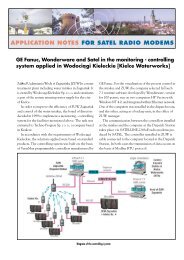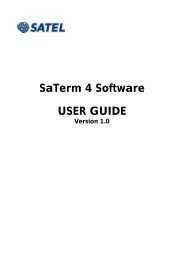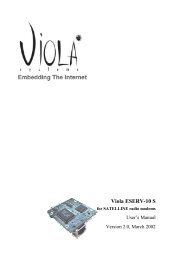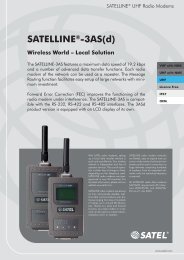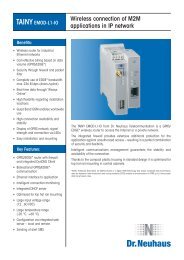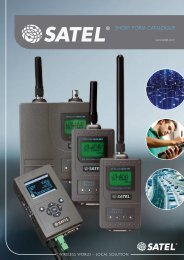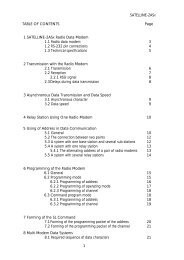SATELLINE® -3AS(d) - Satel Norge
SATELLINE® -3AS(d) - Satel Norge
SATELLINE® -3AS(d) - Satel Norge
You also want an ePaper? Increase the reach of your titles
YUMPU automatically turns print PDFs into web optimized ePapers that Google loves.
A N T E N N A S E L E C T I O N<br />
HOW TO SELECT<br />
YOUR ANTENNA<br />
With proper antenna selection, the<br />
overall performance of a radio network<br />
can be significantly improved.<br />
Proper antenna configuration makes<br />
a network more controlled, closed,<br />
and tolerant to possible interference.<br />
ANTENNA TYPES<br />
There are three types of antennas<br />
distinguished by radiation characteristics:<br />
omni-directional antennas, offset-pattern<br />
antennas and directional<br />
antennas. The usage of different<br />
antenna types is highly dependent<br />
on the shape and nature of the radio<br />
network: point to point, point to<br />
multipoint, number of base stations,<br />
fixed or mobile substations, possible<br />
repeaters, diversity reception, etc.<br />
POINT TO POINT NETWORKS<br />
In point to point, fixed radio networks,<br />
it is always highly recommended<br />
to use directional antennas<br />
(see diagram for CAY, CAY+,<br />
CAY++, CAY+++, CAY++++) when<br />
applicable. This is because of better<br />
control over the system and closed<br />
construction: the signal is forced<br />
and noise collected only to and from<br />
the relevant directions. This also<br />
minimizes the total amount of radio<br />
interference in general.<br />
POINT TO MULTIPOINT<br />
NETWORKS<br />
In point to multipoint radio networks,<br />
one or multiple base stations are<br />
serving multiple substations—fixed<br />
or mobile. Typically, base stations<br />
are equipped with omni-directional<br />
(CAE2, CAE4, CAGP, CAGP+) or offset<br />
pattern antennas (CAC2, CAC4)<br />
in order to serve substations inside a<br />
big angle. Usually, the system layout<br />
is not symmetrical nor is the base station<br />
in the symmetrical center point.<br />
In these cases, the offset pattern base<br />
station antenna is the best choice.<br />
If all the substations are within a<br />
small angle, the directional base<br />
station antenna is recommended for<br />
the reasons mentioned above. The<br />
fixed substations should always be<br />
equipped with directional antennas.<br />
The mobile substations usually have<br />
to be equipped with omni-directional<br />
antennas.<br />
REPEATER STATIONS<br />
When using repeaters, transparent of<br />
buffering, each repeater output has<br />
to be considered as a base station<br />
for its own subsystem and the corresponding<br />
antennas chosen accordingly<br />
for both the base station and<br />
substations.<br />
DIVERSITY (DUAL)<br />
ANTENNAS<br />
In space diversity applications, dual<br />
antennas, chosen as mentioned<br />
above, they are used and located<br />
physically separated on a vertical<br />
or horizontal axis. In polarization<br />
diversity, the special cross-polarized<br />
antennas (CAX, CAX+, CAX++) can<br />
be used. Multiple antennas can also<br />
be combined to form arrays in order<br />
to find more gain and radiation pattern<br />
combinations to meet the requirements.<br />
The antennas are combined<br />
with power splitters (CS) to maintain<br />
the impedance match. When mounting<br />
the antennas at high locations, it<br />
is also recommended to use separate<br />
lightning protectors (LP) to ensure the<br />
radio modem against lightning striking<br />
the antenna, mast or surroundings.<br />
25



